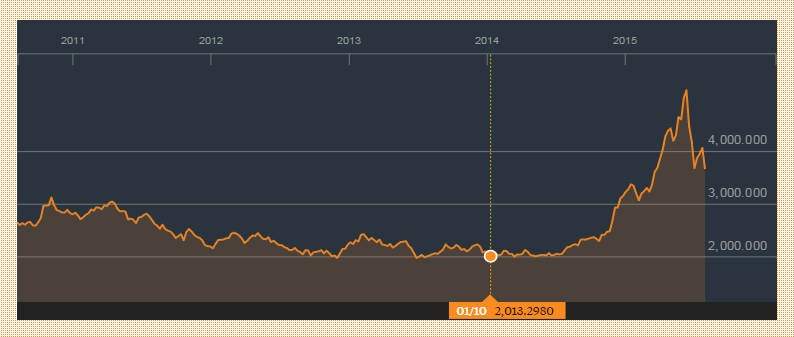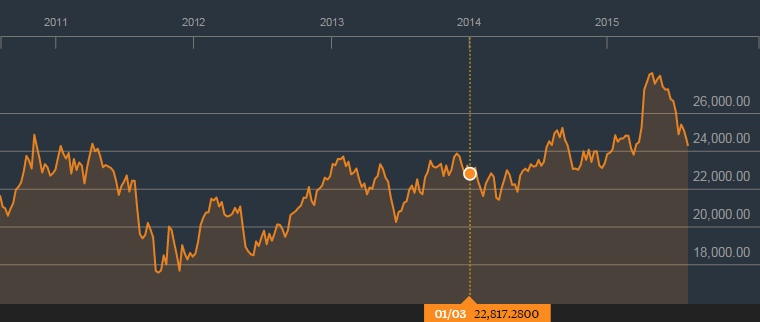In January 2014, the Shanghai Composite Index was hovering at around 2,000. ![]()
Today, it’s ‘down’ to just above 3,600 and everyone from Beijing to London is gnashing teeth and wrenching hands over the great Chinese stock market crash of 2015.
However, in the light of the massive gains of the past two years, the current bear market seems more like a correction than a crash. You wouldn’t know it, though, from the response of China’s one-party state, which has intervened in just about every way imaginable to prop up the equities market.
Part of the anxiety, both in China and abroad, is due to the country’s role in the global economy — as the era of double-digit annual growth slows to ‘just’ 6% or 7% growth, global demand from the world’s largest economy will invariably slow. That will have a global impact. But no one expected China to grow at spectacularly outsized rates for decades without end, and that alone isn’t necessarily enough to torpedo the US or European economies. The ups and downs of China’s wild stock markets, moreover, aren’t necessarily correlated with long-term economic growth. That doesn’t obviate some of the real harms suffered by largely unsophisticated retail investors who dumped their savings into Chinese stocks during the rally of the past year and a half.
This underlines that the real crisis is political, not economic. Under pressure to ‘do something,’ the Chinese Communist Party (中国共产党) is doing a little of everything — devaluing the yuan, halting new IPOs, prohibiting trading in some of the hardest-hit stocks, buying stock in an attempt to keep prices artificially high, cutting interest rates. Certain institutional investors will not be permitted to trade (i.e. sell) stocks for up to six months.
It’s a panicky response that only further perpetuates the ‘crash’ narrative and further sell-offs. But it’s also the response of a governing regime that knows — and knows that the Chinese people know — there’s no competing political party to blame. Chinese leaders often argue that the one-party system incentivizes long-term policy planning because there’s no short-term gains to be had from elections every two years. But the acute knowledge that the Communist Party owns every policy (and every policy misstep) cuts both ways. The current stock market turbulence shows that Chinese Communists, just like American Republicans or Democrats, aren’t above taking hasty steps to end short-term political pain.
It’s also the first major political setback for Xi Jinping since he assumed power as China’s paramount leader in late 2012. Xi’s crackdown on corruption — at the same time genuine and cunningly designed to limit opponents — has helped make him the most powerful Chinese leader since the 1980s. Even though Xi has struggled to fill out his slogan-y ‘Chinese Dream’ concept with real policy prescriptions, nothing about a stock market crash inspires confidence that Xi can sustain a millions-strong aspirational middle class.
A calmer embrace of the more rational ‘correction’ narrative would have done more to reduce panic. Even today, an investor that started buying stocks at the beginning of 2015 is still looking at some impressive returns.
Too much doubt swirls around the integrity of Chinese markets (to say nothing of official statistics), and the Chinese government could be doing much more to encourage widespread foreign investment in both the Shanghai stock exchange and the more tech-heavy Shenzen exchange. After all, it was only in November 2014 that China even opened its stock market to foreign investors. Just a few months later, there are still nagging doubts that insider trading is rife, and that Chinese equities markets, comprised overwhelmingly of public and state-sponsored companies, are stacked in favor of elites. China’s financial regulator, the Chinese Securities Regulatory Commission, tripled fines for insider trading last year, but its regulatory zeal falls far short of the standards in London or Washington.
Compare the performance of Hong Kong’s Hang Seng index. It too saw a sharp rise in 2015 and a corresponding dropoff since June, but not to the same extremes as either Shanghai or Shenzen:
Most importantly, the government’s response to the current stock market crisis is a dress rehearsal for how it might deal with a major slowdown in GDP growth or even a full-blown recession.
So much of the breakneck growth of the past decade has increasingly come from state-manufactured demand to compensate for a slowing export market as wages rise and poorer countries, like Cambodia and Vietnam, undermine Chinese manufacturers on costs. It’s one thing to build Potemkin cities like Ordos when your population growth is skyrocketing; it’s quite another thing when your population is peaking — and aging.
Xi’s cautious fiscal reforms last year indicated a genuine attempt to recalibrate China’s policy, especially insofar as they rebalanced the responsibilities between the national and provincial and local governments, which borrowed extensively over the past decade and a half through opaque off-balance-sheet financing with little or no oversight. The reforms also attempted to restructure China’s tax system and make the state sector more efficient. Xi’s government has weakened the ‘one child’ policy implemented in the 1970s, hopefully ameliorating some of China’s forecast demographic decline.
Chinese policy in the past two months, however, suggests that reform will take a back seat if broader economic indices are at risk.
One lesson that China’s policymakers could take from the summer stock market debacle is that it has rested on its laurels for two decades, content to glide on easy state-sponsored growth, coastal development and cheap exports. Notwithstanding the tightening political controls in the first years of the Xi era, his legacy may come down to one question — whether he’s willing to lead another wave of economic liberalization and not just use the levers of public investment to goose returns to mask and avoid underlying weakness.

